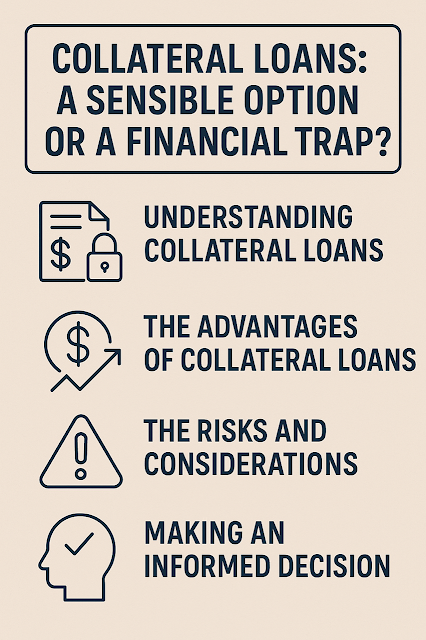Ad Code
Translate
List of 6,000+ Dofollow Commentluv Blogs FREE (Updated 2025)
What is Ozempic (semaglutide)? (Updated in 2025)
How To Find Suitable Properties In Cyprus? (Updated in 2025)
Smart strategies for trading on crypto exchanges
Collateral Loans: A Sensible Option or a Financial Trap?
Understanding Collateral Loans
A collateral loan is a type of financing where the borrower offers an asset as security for the loan. The lender holds the asset until the loan is repaid, reducing their risk and often allowing for more favourable loan terms. Unlike unsecured loans, which rely solely on creditworthiness, collateral loans provide lenders with assurance, making them more accessible to individuals with less-than-perfect credit histories.
Common forms of collateral include real estate, jewellery, and vehicles. Car-backed loans are particularly popular, as they allow borrowers to retain use of their vehicle while securing the loan amount.
The Advantages of Collateral Loans
1. Easier Approval Process
Since the loan is secured against an asset, lenders are more likely to approve applications, even for those with poor credit scores. This makes collateral loans an attractive option for individuals struggling to obtain traditional personal loans.
2. Lower Interest Rates
Secured loans often come with lower interest rates compared to unsecured loans, as lenders have the reassurance of reclaiming the collateral in case of default. This can make repayment more manageable over time.
3. Larger Loan Amounts
With an asset backing the loan, borrowers can access higher amounts than they might with an unsecured loan. The loan sum is typically determined by the market value of the collateral.
4. Flexible Repayment Terms
Many lenders offer adaptable repayment schedules, allowing borrowers to select a timeframe that suits their financial circumstances. This flexibility can ease financial pressure and prevent unnecessary stress.
The Risks and Considerations
1. Risk of Losing Your Asset
The primary risk of a collateral loan is repossession. If you default on payments, the lender has the legal right to seize and sell your asset to recover the loan balance. This can have severe consequences if the asset in question is a vehicle you rely on for daily transport.
2. Market-Dependent Loan Values
The amount you can borrow depends on the current market value of your asset. If its value depreciates significantly, you may not receive the amount you need, or you might be left owing more than the asset is worth.
3. Potential for High Fees and Charges
While interest rates are often lower than those for unsecured loans, some lenders impose hidden fees, including administrative costs and early repayment penalties. It is essential to read the loan agreement carefully to understand the full financial commitment.
4. Debt Cycle Risks
If a borrower struggles to repay the loan and takes out additional loans to cover it, they may fall into a debt cycle, where accumulating interest and fees make repayment increasingly difficult. Responsible borrowing is crucial to avoid long-term financial issues.
Making an Informed Decision
Collateral loans can be a lifeline for those in urgent need of cash, but they must be approached with caution. Before taking out a secured loan, consider the following:
-
Assess your ability to repay the loan on time.
-
Compare different lenders and their terms.
-
Read the fine print to check for hidden fees.
-
Ensure the loan suits your financial situation and does not create further financial strain.
For those looking for a reliable way to secure a short-term loan using their car, https://scwcars.com.au/ may be worth exploring. However, always conduct due diligence before committing to any financial arrangement.
Final Thoughts
Collateral loans can be a practical financial solution when managed responsibly. They offer quick access to funds, lower interest rates, and flexible repayment terms, but they also carry the risk of asset loss and financial strain if not carefully handled. Whether a collateral loan is a sensible choice or a financial trap ultimately depends on the borrower’s ability to manage repayments and their overall financial situation.



0 Comments